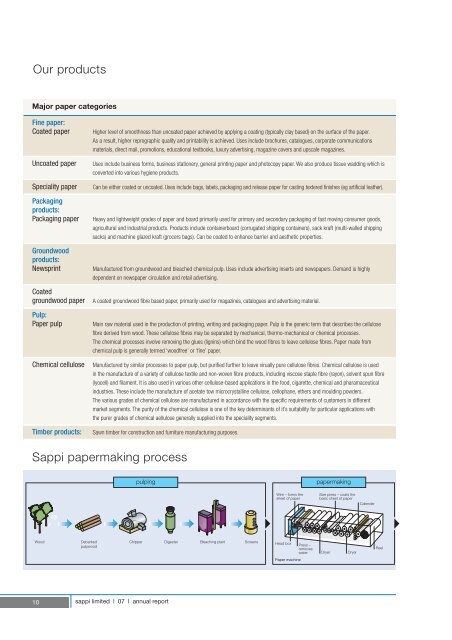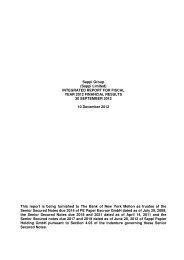2007 Annual Report - Sappi
2007 Annual Report - Sappi
2007 Annual Report - Sappi
You also want an ePaper? Increase the reach of your titles
YUMPU automatically turns print PDFs into web optimized ePapers that Google loves.
Our products<br />
Major paper categories<br />
Fine paper:<br />
Coated paper<br />
Uncoated paper<br />
Speciality paper<br />
Packaging<br />
products:<br />
Packaging paper<br />
Groundwood<br />
products:<br />
Newsprint<br />
Coated<br />
groundwood paper<br />
Pulp:<br />
Paper pulp<br />
Chemical cellulose<br />
Timber products:<br />
Higher level of smoothness than uncoated paper achieved by applying a coating (typically clay based) on the surface of the paper.<br />
As a result, higher reprographic quality and printability is achieved. Uses include brochures, catalogues, corporate communications<br />
materials, direct mail, promotions, educational textbooks, luxury advertising, magazine covers and upscale magazines.<br />
Uses include business forms, business stationery, general printing paper and photocopy paper. We also produce tissue wadding which is<br />
converted into various hygiene products.<br />
Can be either coated or uncoated. Uses include bags, labels, packaging and release paper for casting textered finishes (eg artificial leather).<br />
Heavy and lightweight grades of paper and board primarily used for primary and secondary packaging of fast moving consumer goods,<br />
agricultural and industrial products. Products include containerboard (corrugated shipping containers), sack kraft (multi-walled shipping<br />
sacks) and machine glazed kraft (grocers bags). Can be coated to enhance barrier and aesthetic properties.<br />
Manufactured from groundwood and bleached chemical pulp. Uses include advertising inserts and newspapers. Demand is highly<br />
dependent on newspaper circulation and retail advertising.<br />
A coated groundwood fibre based paper, primarily used for magazines, catalogues and advertising material.<br />
Main raw material used in the production of printing, writing and packaging paper. Pulp is the generic term that describes the cellulose<br />
fibre derived from wood. These cellulose fibres may be separated by mechanical, thermo-mechanical or chemical processes.<br />
The chemical processes involve removing the glues (lignins) which bind the wood fibres to leave cellulose fibres. Paper made from<br />
chemical pulp is generally termed ‘woodfree’ or ‘fine’ paper.<br />
Manufactured by similar processes to paper pulp, but purified further to leave virually pure cellulose fibres. Chemical cellulose is used<br />
in the manufacture of a variety of cellulose textile and non-woven fibre products, including viscose staple fibre (rayon), solvent spun fibre<br />
(lyocell) and filament. It is also used in various other cellulose-based applications in the food, cigarette, chemical and pharamaceutical<br />
industries. These include the manufacture of acetate tow microcrystalline cellulose, cellophane, ethers and moulding powders.<br />
The various grades of chemical cellulose are manufactured in accordance with the specific requirements of customers in different<br />
market segments. The purity of the chemical cellulose is one of the key determinants of it’s suitability for particular applications with<br />
the purer grades of chemical aellulose generally supplied into the speciality segments.<br />
Sawn timber for construction and furniture manufacturing purposes.<br />
<strong>Sappi</strong> papermaking process<br />
pulping<br />
papermaking<br />
Wire – forms the<br />
sheet of paper<br />
Size press – coats the<br />
basic sheet of paper<br />
Calender<br />
Wood<br />
Debarked<br />
pulpwood<br />
Chipper Digester Bleaching plant Screens<br />
Head box<br />
Press –<br />
removes<br />
water<br />
Dryer<br />
Dryer<br />
Reel<br />
Paper machine<br />
10<br />
sappi limited | 07 | annual report
















